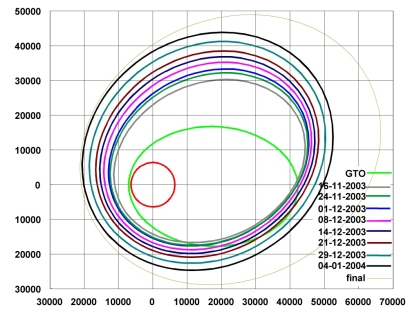No. 14 - SMART-1 Finally Escapes the Radiation Belts
Between 23 December 2003 and 2 January 2004, the thruster fired continuously for a record duration of more than 240 hours. This is likely to remain the record for some time because later this week SMART-1 will change from a continuous thrust strategy to a more orbitally efficient thrust arcing.
The total cumulated thrust so far of more than 1500 hours, consuming 24 kg of Xenon, has provided a velocity increment of about 1070 ms-1 (equivalent to 3850 km per hour). The electric propulsion engine's performance, periodically monitored by means of the telemetry data transmitted by the spacecraft and by radio-tracking by the ground stations, continues to show a small over performance in thrust: varying from 1.1% to 1.5% over the last week.
The degradation of the electrical power produced by the solar arrays has now ceased. The power available has remained virtually constant since November 2003.
The communication, data handling, on-board software and thermal subsystems have been performing well in this period.
Orbital/Trajectory information
The osculating orbital elements are periodically computed by the ESOC specialists. These elements define the so called "osculating orbit" which would be travelled by the spacecraft if at that instant all perturbations, including EP thrust, would cease. So it is an image of the situation at that epoch. In reality the path travelled by the spacecraft is a continuous spiral leading from one orbit to another. The most recent osculating elements are as follows:
|
EPOCH (UTC) 2004/01/04 16:58:13.9 Elements WRT Earth (J2000) |
|
| Pericentre Distance (km) |
19 179.426559 |
| Apocentre Distance (km) |
56 437.665420 |
| Semi Major Axis (km) |
37 808.545990 |
| Eccentricity |
0.492722 |
| Inclination (deg) |
6.842437 |
| Asc. Node (deg) |
150.947201 |
| Arg. of Pericentre (deg) |
211.092921 |
| True Anomaly (deg) |
179.997188 |
| Osc. Orbital Period (h) |
20.323264 |
In this diagram the osculating orbits at launch (GTO) and at different times are plotted. The large orbit, marked 'final', is not exactly the same as the one we expect to reach on 7 January. This is due to the change in strategy devised in order to avoid an excessive increase of the apogee height, which would have produced several long eclipses in March (Status Report No. 11, 16 December 2003). The thrust arcs, for the same reason, will, for the next few weeks, be concentrated for a few hours around the perigee point in order to efficiently tune the altitude of the apogee to the maximum allowable duration for the March eclipses (2 hours and 15 minutes).
 |
From the start the electric propulsion system has managed to increase the semi-major axis of the orbit by 13 179 km and increasing the perigee altitude from the original 656 km to 12 801 km. The orbital period has almost been doubled from the initial 10 hours 41 minutes to the present 20 hours and 19 minutes.
Contact Point
Giuseppe Racca
SMART-1 Project Manager
ESA/ESTEC - SCI-PD
Keplerlaan 1- 2200 AG Noordwijk, The Netherlands
E-mail: Giuseppe.Racca esa.int
esa.int

